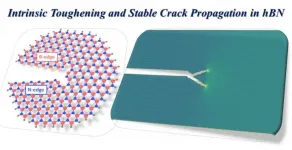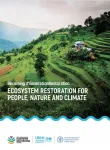(Press-News.org) A team of scientists led by Nanyang Technological University (NTU Singapore) and Rice University in the US, has uncovered the key to the outstanding toughness of hexagonal boron nitride (h-BN). h-BN can withstand ten times the amount of force that graphene can, which is known as one of the toughest materials on Earth.
A two-dimensional (2D) material, h-BN has a thickness of just one atom. First used in cosmetics in the 1940s, it was soon abandoned due to its high price, making a resurgence in the late 1990s after technology made its production cheaper.
Today, it is used by nearly all leading producers of cosmetic products because of its ability to absorb excess facial sebum and disperse pigment evenly, and as a protective layer in 2D electronics, as it insulates against electricity and withstands temperatures of up to 1000 °C.
The NTU and Rice scientists said their new understanding of the compound's unique properties could pave the way to designing new flexible materials for electronics.
When scientists examined h-BN that had been exposed to stress, they saw that any breakages in the material branched like forks in a road, instead of travelling straight through the material (see Image 3), and meaning that fractures in h-BN are less likely to grow when further stress is applied.
Elaborating on the significance of their findings, Professor Gao Huajian, a Distinguished University Profesor in NTU's School of Mechanical and Aerospace Engineering, who led the study, said: "Our experiments show that h-BN is the toughest nanomaterial measured to date. What makes this work so exciting is that it unveils an intrinsic toughening mechanism in this material - which should be brittle as it is only one atom thick. This is unexpected as there is often a trade-off between the strength and brittleness of nanomaterials."
This latest research breakthrough is another of Prof Gao's achievements in the field of applied mechanics. He was recently awarded the prestigious 2021 Timoshenko Medal by the American Society of Mechanical Engineers (ASME)[1] in recognition of his pioneering contributions to nanomechanics of engineering and biological systems, a new research field at the interface of solid mechanics, materials science and biophysics.
Professor Lou Jun, from Rice University's Department of Materials Science and NanoEngineering, who also led the study, said: "In the real world, no material is free from defects, which is why understanding fracture toughness - or resistance to crack growth - is so important in engineering. It describes how much punishment a real-world material can withstand before failing."
The research was published in the top scientific journal Nature in June.
Unveiling the secret behind h-BN's toughness
After 1,000 hours of lab experiments and the use of computer simulations, the scientists traced the vastly different fracture toughness of graphene and h-BN to their chemical compositions.
Like a honeycomb, both h-BN and graphene are arranged in interconnecting hexagons (see Image 3). However, the hexagons in graphene consist solely of carbon atoms, while each hexagon structure in h-BN consists of three nitrogen and three boron atoms.
This difference in composition is what causes a moving crack in h-BN to branch off its path, and this tendency to branch or turn means it takes more energy for a crack to be driven further into it. By contrast, graphene breaks more easily, as fractures travel straight through the material like a zipper.
The researchers say that h-BN's surprising toughness could make it the ideal option for making tear-resistant flexible electronics, such as wearable medical devices and foldable smartphones. It could also be added to strengthen electronics made from two-dimensional (2D) materials, which tend to be brittle.
Besides its flexibility, h-BN's heat resistance and chemical stability would allow it to serve as both a supporting base and an insulating layer between electronic components, setting it apart from other traditional materials used in electronics.
Elaborating on the future applications of their study, Prof Gao said: "Our findings also point to a new route to produce tough materials by adding structural asymmetry into their designs. This would reduce the likelihood of materials fracturing under extreme stress, which may cause the devices to fail and lead to catastrophic effects."
Prof Lou added: "The niche area for 2D material-based electronics like h-BN are in flexible electronic devices. In addition to applications like electronic textiles, 2D electronic devices are thin enough for more exotic applications like electronic tattoos and implants that could be attached directly to the brain."
The scientists are now using their findings to explore new methods to produce tougher materials for mechanical and electronic manufacturing.
INFORMATION:
Mangrove vegetation, which grows naturally in subtropical shorelines, provides a wide range of ecosystem functions such as reducing coastal erosion, promoting biodiversity, and removing nitrogen, phosphorus and carbon dioxide. These vital ecological functions are influenced by the water flow around the intricate mangrove roots, which create a complex energetic process that mixes up sediments and generates a depositional region behind the roots. How these mangrove roots interact with water flow is believed to be a key element in mitigating coastal erosion.
Accurately projecting hydrodynamic erosion and the essential amount of mangrove species has been a challenge for managers and restoration experts to forecast a successful component of project designs. That is because ...
WASHINGTON (June 3, 2021) - Nearly three-quarters of breast cancer patients (73%) report using at least one type of complementary medicine after cancer diagnosis, while oncologists believe that less than half (43%) of patients are using these approaches during cancer care. These and other findings from a national survey of oncologists and breast cancer patients were released in conjunction with the 2021 ASCO Annual Meeting. The study found that doctors report discussing integrative health with only about half of patients, leading patients to seek information outside the clinic.
"Cancer is a complex ...
Astronomers studying the fast-moving jet of material ejected by a still-forming, massive young star found a major difference between that jet and those ejected by less-massive young stars. The scientists made the discovery by using the U.S. National Science Foundation's Karl G. Jansky Very Large Array (VLA) to make the most detailed image yet of the inner region of such a jet coming from a massive young star.
Both low- and high-mass young stars, or protostars, propel jets outward perpendicular to a disk of material closely orbiting the star. In stars with masses similar to the Sun, these jets are narrowed, or focused, relatively tightly near to the star in a process called collimation. Because most high-mass protostars are more distant, studying ...
New research into Alzheimer's disease (AD) suggests that secondary infections and new inflammatory events amplify the brain's immune response and affect memory in mice and in humans - even when these secondary events occur outside the brain.
Scientists believe that key brain cells (astrocytes and microglia) are already in an active state due to inflammation caused by AD and this new research shows that secondary infections can then trigger an over-the-top response in those cells, which has knock-on effects on brain rhythms and on cognition.
In the study, just published in Alzheimer's & Dementia, the journal ...
Facing the triple threat of climate change, loss of nature and pollution, the world must deliver on its commitment to restore at least one billion degraded hectares of land in the next decade - an area about the size of China. Countries also need to add similar commitments for oceans, according to a new report by the UN Environment Programme (UNEP) and the Food and Agriculture Organization of the UN (FAO), launched as the UN Decade on Ecosystem Restoration 2021-2030 gets underway.
The report, #GenerationRestoration: Ecosystem restoration for People, Nature and Climate, highlights that humanity is using about 1.6 times the amount of services that nature can provide sustainably.
That ...
June 3, 2021 - LA JOLLA, CA--Mining the world's most comprehensive drug repurposing collection for COVID-19 therapies, scientists have identified 90 existing drugs or drug candidates with antiviral activity against the coronavirus that's driving the ongoing global pandemic.
Among those compounds, the Scripps Research study identified four clinically approved drugs and nine compounds in other stages of development with strong potential to be repurposed as oral drugs for COVID-19, according to results published June 3 in the journal Nature Communications.
Of the drugs that prevented the coronavirus from replicating in human cells, 19 were found to work in concert with or boost the activity of remdesivir, an antiviral therapy approved ...
MIT researchers have created the first fiber with digital capabilities, able to sense, store, analyze, and infer activity after being sewn into a shirt.
Yoel Fink, who is a professor of material sciences and electrical engineering, a Research Laboratory of Electronics principal investigator, and the senior author on the study, says digital fibers expand the possibilities for fabrics to uncover the context of hidden patterns in the human body that could be used for physical performance monitoring, medical inference, and early disease detection.
Or, you might someday store your wedding music in the gown you wore on the big day -- more on that later.
Fink and his colleagues describe the features of the digital fiber in Nature Communications. Until now, electronic fibers ...
The number of people engaging with life-enhancing cardiac rehabilitation clinics has declined during the pandemic, according to a BMJ clinical update which makes the case for more home-based and virtual alternatives.
Before the covid-19 pandemic, 100?000 people were admitted to hospital with heart attacks and approximately 200?000 were diagnosed with heart failure annually in the UK. There was a 40% decline in the number of patients admitted with heart attacks (acute coronary syndromes ) in 2020.
Cardiac rehabilitation is crucial to helping people who have encountered a heart attack or heart failure have a better quality of life. Now, a new review, undertaken by cardiac rehabilitation experts based at the ...
WASHINGTON, DC - JUNE 3, 2021 -- A new West Health/Gallup survey finds nearly all Democrats (97%) and the majority of Republicans (61%) support empowering the federal government to negotiate lower prices of brand-name prescription drugs covered by Medicare. Overall, 8 in 10 Americans prefer major government action to control prices over concerns about it hurting innovation and competition from the pharmaceutical industry. The results come from a nationally representative poll of more than 3,700 American adults.
While President Joe Biden, Democrats in Congress and former President Donald Trump have called for such negotiation, ...
If you have ever tried to chip a mussel off a seawall or a barnacle off the bottom of a boat, you will understand that we could learn a great deal from nature about how to make powerful adhesives. Engineers at Tufts University have taken note, and today report a new type of glue inspired by those stubbornly adherent crustaceans in the journal Advanced Science.
Starting with the fibrous silk protein harvested from silkworms, they were able to replicate key features of barnacle and mussel glue, including protein filaments, chemical crosslinking and iron bonding. The result is a powerful non-toxic glue that sets and works as well underwater as it does in dry conditions and is stronger than most synthetic glue products now on the ...





